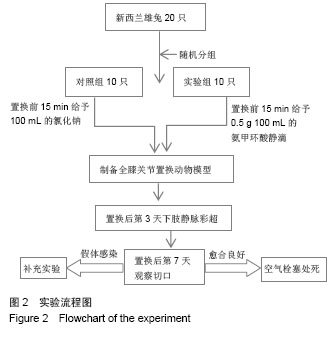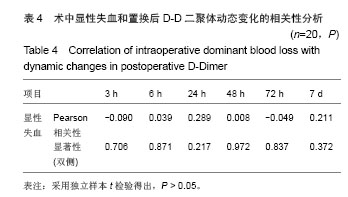| [1]Fuqiang G, Wanshou G, Wei S, et al. Correlation between the coverage percentage of prosthesis and postoperative hidden blood loss in primary total knee arthroplasty. Chin Med J. 2014; 127(12): 2265-2269.
[2]Sehat KR, Evans RL, Newman JH. Hidden blood loss following hip and knee arthroplasty correct management of blood loss should take hidden loss into account. J Bone Joint Surg. 2004; 86(4):561-565.
[3]Shen H, Li Z, Feng M, et al. Analysis on hidden blood loss of total knee arthroplasty in treating knee osteoarthritis. Chin Medical J. 2011;124(11):1653.
[4]Benoni G, Lethagen S, Nilsson P, et al. Tranexamic acid, given at the end of the operation, does not reduce postoperative blood loss in hip arthroplasty. Acta Orthop. 2000;71(3):250-254.
[5]Cid J, Lozano M. Tranexamic acid reduces allogeneic red cell transfusions in patients undergoing total knee arthroplasty: results of a meta-analysis of randomized controlled trials. Transfusion. 2005;45(8):1302-1307.
[6]Wong J, Abrishami A, El Beheiry H, et al. Topical application of tranexamic acid reduces postoperative blood loss in total knee arthroplasty: a randomized, controlled trial. J Bone Joint Surg Am 2010;92(15):2503.
[7]Ishida K,Tsumura N,Kitagawa A, et al. Intra-articular injection of tranexamic acid reduces not only blood loss but also knee joint swelling after total knee arthroplasty. Int Orthop. 2011;35: 1639-1645.
[8]MacGillivray RG, Tarabichi SB, Hawari MF, et al. Tranexamic acid to reduce blood loss after bilateral total knee arthroplasty: a prospective, randomized double blind study. J Arthroplasty. 2011;26(1): 24-28.
[9]Karam JA, Bloomfield MR, DiIorio TM, et al. Evaluation of the efficacy and safety of tranexamic acid for reducing blood loss in bilateral total knee arthroplasty. J Arthroplasty. 2014;29(3): 501-503.
[10]Iwai T, Tsuji S, Tomita T, et al. Repeat-dose intravenous tranexamic acid further decreases blood loss in total knee arthroplasty. Int Orthop. 2013;37(3): 441-445.
[11]Gandhi R, Evans H M, Mahomed S R, et al. Tranexamic acid and the reduction of blood loss in total knee and hip arthroplasty: a meta-analysis. BMC Res Notes. 2013;6(1): 184.
[12]Gillette BP, DeSimone LJ, Trousdale RT, et al. Low risk of thromboembolic complications with tranexamic acid after primary total hip and knee arthroplasty. Clin Orthop Relat Res 2013;471(1):150.
[13]Aguilera X, Martinez-Zapata MJ, Bosch A. Efficacy and safety of fibrin glue and tranexamic Acid to prevent postoperative blood loss in total knee arthroplasty: a randomized controlled clinical trial. J Bone Joint Surg. 2013;95(22):2001-2007.
[14]Ma YQ, Zhang YC, Zhang H. [Local application of tranexamic acid reduces blood less in unilateral total knee arthroplasty: a retrospective comparason analysis]. Zhonghua Waike Zazhi. 2013;51(1):40-43.
[15]Vigna-Taglianti F, Basso L, Rolfo P, et al. Tranexamic acid for reducing blood transfusions in arthroplasty interventions: a cost-effective practice. Eur J Orthop Surg Traumatol. 2013: 1-7.
[16]Sarzaeem MM, Razi M, Kazemian G, et al. Comparing Efficacy of Three Methods of Tranexamic Acid Administration in Reducing Hemoglobin Drop Following Total Knee Arthroplasty. J Arthroplasty. 2014.
[17]Seo JG, Moon YW, Park SH, et al. The comparative efficacies of intra-articular and IV tranexamic acid for reducing blood loss during total knee arthroplasty. Knee Surg Sports Traumatol Arthrosc. 2013;21(8):1869.
[18]Ahlberg A, Eriksson O, Kjellman H. Diffusion of tranexamic acid to the joint. Acta Orthopaedica. 1976;47(5): 486-488.
[19]Nilsson IM. Clinical pharmacology of aminocaproic and tranexamic acids. J Clin Pathol. 1980;33(Suppl 14):41-47.
[20]Benoni G, Lethagen S, Nilsson P, et al. Tranexamic acid, given at the end of the operation, does not reduce postoperative blood loss in hip arthroplasty. Acta Orthop Scand. 2000;71:250-254.
[21]Good L, Peterson E, Lisander B. Tranexamic acid decreases external blood loss but not hidden blood loss in total knee replacement. Br J Anaesth. 2003;90(5):596.
[22]Lin PC, Hsu CH, Chen WS, et al. Does tranexamic acid save blood in minimally invasive total knee arthroplasty? Clin Orthop Relat Res. 2011;469(7):1995.
[23]余世明,刘建华,徐栋梁,等.兔用生物型人工膝关节假体的设计与制作[J].中华关节外科杂志(电子版), 2009,3(4):63-66.
[24]Bao N, Zhou L, Cong Y, et al. Free fatty acids are responsible for the hidden blood loss in total hip and knee arthroplasty. Med Hypoth. 2013;133(1)104-107.
[25]McManus KT, Velchik MG, Alavi A, et al. Non-invasive assessment of postoperative bleeding in TKA patients with Tc-99m RNCs. J Nuclear Med. 1987;28(8): 565-567.
[26]Zampelis V, Tägil M, Lidgren L, et al. The effect of a biphasic injectable bone substitute on the interface strength in a rabbit knee prosthesis model. J Orthop Surg Res. 2013; 8(1): 25.
[27]Mauerer A, Lange B, Welsch GH, et al. Release of Cu2+ from a copper-filled TiO2 coating in a rabbit model for total knee arthroplasty. J Mat Sci. 2014;25(3):813-821.
[28]余世明,刘建华,徐栋梁,等.兔用生物型人工膝关节假体的设计与制作[J].中华关节外科杂志(电子版), 2009,3(4):63-66.
[29]严志强,张乐,王新亮,等.计算机辅助设计兔解剖型人工膝关节假体[J].广东医学,2014,35(13):1997-2001.
[30]严俊伟,唐成,李祥全,等.全膝关节置换术后感染模型的建立[J]. 中华关节外科杂志(电子版),2014,8(1):60-64.
[31]高福强,李子剑,刘延青,等.初次全膝关节置换术后肢体肿胀程度与隐性失血量的相关性研究[J].中国矫形外科杂志,2011,19(3): 199-202.
[32]Randelli F, D’Anchise R, Ragone V, et al. Is the newest fibrin sealant an effective strategy to reduce blood loss after total knee arthroplasty? A randomized controlled study. J Arthroplasty. 2014;29(8):1516-1520.
[33]Alshryda S,Mason J,Vaghela M,et al.Topical(intra-articular) tranexamic acid reduces blod los and transfusion rates folowingtotal kne replacement:a randomized controled trial(TRANX-K).J Bone Joint Surg Am. 2013;95 (21):1961-1968.
[34]Wind TC, Barfield WR, Moskal JT. The effect of tranexamic acid on transfusion rate in primary total hip arthroplasty. J Arthroplasty. 2014; 29(2):387-389.
[35]甘伟伟,刘斌,谢贵杰.氨甲环酸应用时机对髋关节置换手术患者失血量影响的研究[J].安徽医药, 2014,18(8):1569-1571.
[36]Alcelik I, Pollock RD, Sukeik M, et al. A comparison of outcomes with and without a tourniquet in total knee arthroplasty: a systematic review and meta-analysis of randomized controlled trials. J Arthroplasty. 2012;27(3): 331-340.
[37]Zan PF, Yang Y, Fu D, et al. Releasing of tourniquet before wound closure or not in total knee arthroplasty: a meta-analysis of randomized controlled trials. J Arthroplasty. 2015;30(1):31-37.
[38]陈虎,曹力,杨德盛,等.麻醉方式与全膝关节置换术后深静脉血栓发生率分析[J].中国矫形外科杂志, 2012, 20(5): 402-405.
[39]Jiang X, Hand AR, Shen S, et al. Enhanced tissue plasminogen activator synthesis by the sympathetic neurons that innervate aging vessels. J Neurosci Res. 2003;71(4): 567-574.
[40]Bell TH, Berta D, Ralley F, et al. Factors affecting perioperative blood loss and transfusion rates in primary total joint arthroplasty: a prospective analysis of 1642 patients. Can J Surg. 2009;52(4): 295.
[41]Mega JL, Braunwald E, Wiviott SD. Low doses of rivaroxaban effectively lower the risk of cardiac events. Am J Cardiol. 2013.
[42]Tai TW,Chang CW,Yang CY,et al. Effects of tourniquet use on blood loss and soft-tissue damage in total knee arthroplasty: a randomized controlled trial. J Bone Joint Surg Am. 2012; 94(24): 2209-2215.
[43]Kumar GS, Von Arx OA, Pozo JL. Rate of blood loss over 48 hours following total knee replacement. Knee. 2005;12(4): 307-309. |






.jpg)